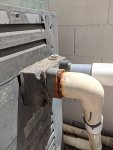Hi there,
I have a leak happening at the inlet of my old RP2100 heater with cast iron header. The outlet was replaced a while back for the same reason, but they could not get the bolts off the current one without fear or breaking everything, so they left it. I am having a hard time figuring out how they connected the CPVC in. It looks like they threaded a CPVC pipe into the flange with cement (Green)? They are telling me to get a new heater, and I'd rather not. I can do the work required if I can get the bolts off, just would rather someone else do it...but they won't. Either way, if I get this off and get the new parts...how is the pipe supposed to go in there? They did work on the pump when it went in as well and they used the same green cement rather than the unions. I didn't know that method was a "thing". At any rate, just trying to figure out the right way to securely connect to this type of header.
Thanks

I have a leak happening at the inlet of my old RP2100 heater with cast iron header. The outlet was replaced a while back for the same reason, but they could not get the bolts off the current one without fear or breaking everything, so they left it. I am having a hard time figuring out how they connected the CPVC in. It looks like they threaded a CPVC pipe into the flange with cement (Green)? They are telling me to get a new heater, and I'd rather not. I can do the work required if I can get the bolts off, just would rather someone else do it...but they won't. Either way, if I get this off and get the new parts...how is the pipe supposed to go in there? They did work on the pump when it went in as well and they used the same green cement rather than the unions. I didn't know that method was a "thing". At any rate, just trying to figure out the right way to securely connect to this type of header.
Thanks


